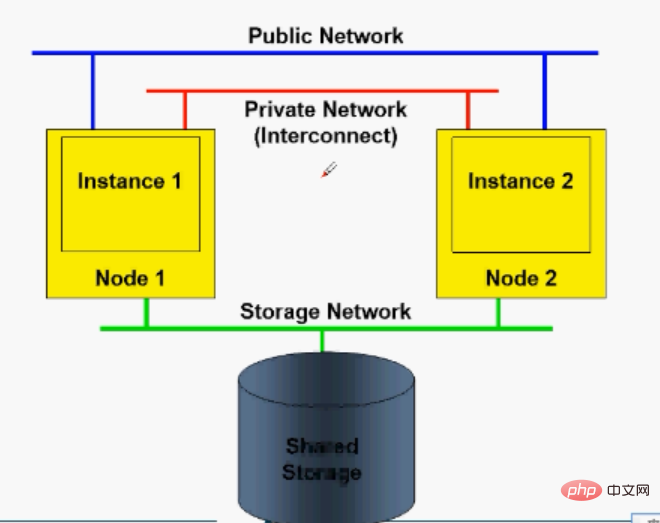what is oraclerac
oracle rac refers to Oracle Real-time Application Cluster, which is a cluster database with a shared cache architecture. It overcomes the limitations of the traditional shared nothing method and shared disk method, and provides a user-friendly solution for all business applications. A highly scalable and available database solution.

The operating environment of this tutorial: Windows 7 system, Oracle 11g version, Dell G3 computer.
What is Oracle RAC
Oracle RAC (real application clusters, "real-time application clusters") is a cluster database with a shared cache architecture , which overcomes the limitations of traditional shared-nothing and shared-disk approaches, providing a highly scalable and available database solution for all your business applications. Oracle RAC is a key component of Oracle Private Cloud architecture.
Oracle RAC can eliminate the single point of failure problem of the database server, thereby providing customers with excellent database availability. In a clustered server environment, the database itself is shared across the server pool, which means that if any server in the pool fails, the database will continue to run on the healthy server. Oracle RAC not only allows customers to continue handling database workloads in the event of a server failure, but it also helps reduce downtime costs by reducing planned offline maintenance of the database.
Oracle RAC supports transparent deployment of Oracle databases on clustered server pools. This allows customers to easily redeploy Oracle Database on a single server to a cluster of database servers, taking advantage of the consolidated memory capacity and processing power provided by clustered database servers.
Oracle RAC provides all the necessary software components to allow you to easily deploy Oracle Database on a server pool and take full advantage of the performance, scalability and availability provided by the cluster. Oracle RAC leverages Oracle Grid Infrastructure as the foundation for the Oracle RAC database system. Oracle Grid Infrastructure includes Oracle Clusterware and Oracle Automatic Storage Management (ASM) to efficiently share server and storage resources in a highly available and scalable database cloud environment.
Advantages:
Oracle RAC mainly supports Oracle9i, 10g, 11g, and 12C versions, and can support 24 x 7 effective database application systems. Build a high-availability database system on low-cost servers and deploy applications freely without modifying the code.
In the Oracle RAC environment, Oracle integration provides cluster software and storage management software, reducing application costs for users. When the application scale needs to be expanded, users can expand the system as needed to ensure system performance.
(1) Multi-node load balancing;
(2) Provide high availability: fault tolerance and seamless switching functions to minimize the impact of hardware and software errors;
(3) Improve transaction response time through parallel execution technology--usually used for data analysis systems;
(4) Increase the number of transactions and connections per second through horizontal expansion--usually for Online transaction system;
(5) Save hardware costs, you can use multiple cheap PC servers to replace expensive minicomputers or mainframes, while saving corresponding maintenance costs;
(6) Expandable It has good performance and can easily add and delete nodes and expand hardware resources.
Disadvantages:
(1) Compared with a single machine, the management is more complex and the requirements are higher;
(2) When the system planning and design is poor, the performance may not even be as good as a single node;
(3) It may increase the software cost (if you use a high-configuration PC server, Oracle generally charges based on the number of CPUs).
Before Oracle9i, the name of RAC was OPS (Oracle parallel Server). A big difference between RAC and OPS is that RAC uses Cache Fusion (cache merging) technology. In OPS, data requests between nodes require the data to be written to disk before the requesting node can read the data. When using Cache fusion, the data buffers of each RAC node transmit data blocks through the high-speed, low-latency internal network.
What problem does rac solve
1. High availability: automatic switching, load balancing
2. High performance: multiple instances, more connections, concurrent execution
3. High expansion: expand nodes without downtime.
RAC architecture

Recommended tutorial: "Oracle Tutorial"
The above is the detailed content of what is oraclerac. For more information, please follow other related articles on the PHP Chinese website!

Hot AI Tools

Undresser.AI Undress
AI-powered app for creating realistic nude photos

AI Clothes Remover
Online AI tool for removing clothes from photos.

Undress AI Tool
Undress images for free

Clothoff.io
AI clothes remover

AI Hentai Generator
Generate AI Hentai for free.

Hot Article

Hot Tools

Notepad++7.3.1
Easy-to-use and free code editor

SublimeText3 Chinese version
Chinese version, very easy to use

Zend Studio 13.0.1
Powerful PHP integrated development environment

Dreamweaver CS6
Visual web development tools

SublimeText3 Mac version
God-level code editing software (SublimeText3)

Hot Topics
 How long will Oracle database logs be kept?
May 10, 2024 am 03:27 AM
How long will Oracle database logs be kept?
May 10, 2024 am 03:27 AM
The retention period of Oracle database logs depends on the log type and configuration, including: Redo logs: determined by the maximum size configured with the "LOG_ARCHIVE_DEST" parameter. Archived redo logs: Determined by the maximum size configured by the "DB_RECOVERY_FILE_DEST_SIZE" parameter. Online redo logs: not archived, lost when the database is restarted, and the retention period is consistent with the instance running time. Audit log: Configured by the "AUDIT_TRAIL" parameter, retained for 30 days by default.
 Function to calculate the number of days between two dates in oracle
May 08, 2024 pm 07:45 PM
Function to calculate the number of days between two dates in oracle
May 08, 2024 pm 07:45 PM
The function in Oracle to calculate the number of days between two dates is DATEDIFF(). The specific usage is as follows: Specify the time interval unit: interval (such as day, month, year) Specify two date values: date1 and date2DATEDIFF(interval, date1, date2) Return the difference in days
 The order of the oracle database startup steps is
May 10, 2024 am 01:48 AM
The order of the oracle database startup steps is
May 10, 2024 am 01:48 AM
The Oracle database startup sequence is: 1. Check the preconditions; 2. Start the listener; 3. Start the database instance; 4. Wait for the database to open; 5. Connect to the database; 6. Verify the database status; 7. Enable the service (if necessary ); 8. Test the connection.
 How to use interval in oracle
May 08, 2024 pm 07:54 PM
How to use interval in oracle
May 08, 2024 pm 07:54 PM
The INTERVAL data type in Oracle is used to represent time intervals. The syntax is INTERVAL <precision> <unit>. You can use addition, subtraction, multiplication and division operations to operate INTERVAL, which is suitable for scenarios such as storing time data and calculating date differences.
 How to see the number of occurrences of a certain character in Oracle
May 09, 2024 pm 09:33 PM
How to see the number of occurrences of a certain character in Oracle
May 09, 2024 pm 09:33 PM
To find the number of occurrences of a character in Oracle, perform the following steps: Get the total length of a string; Get the length of the substring in which a character occurs; Count the number of occurrences of a character by subtracting the substring length from the total length.
 How much memory does oracle require?
May 10, 2024 am 04:12 AM
How much memory does oracle require?
May 10, 2024 am 04:12 AM
The amount of memory required by Oracle depends on database size, activity level, and required performance level: for storing data buffers, index buffers, executing SQL statements, and managing the data dictionary cache. The exact amount is affected by database size, activity level, and required performance level. Best practices include setting the appropriate SGA size, sizing SGA components, using AMM, and monitoring memory usage.
 How to replace string in oracle
May 08, 2024 pm 07:24 PM
How to replace string in oracle
May 08, 2024 pm 07:24 PM
The method of replacing strings in Oracle is to use the REPLACE function. The syntax of this function is: REPLACE(string, search_string, replace_string). Usage steps: 1. Identify the substring to be replaced; 2. Determine the new string to replace the substring; 3. Use the REPLACE function to replace. Advanced usage includes: multiple replacements, case sensitivity, special character replacement, etc.
 Oracle database server hardware configuration requirements
May 10, 2024 am 04:00 AM
Oracle database server hardware configuration requirements
May 10, 2024 am 04:00 AM
Oracle database server hardware configuration requirements: Processor: multi-core, with a main frequency of at least 2.5 GHz. For large databases, 32 cores or more are recommended. Memory: At least 8GB for small databases, 16-64GB for medium sizes, up to 512GB or more for large databases or heavy workloads. Storage: SSD or NVMe disks, RAID arrays for redundancy and performance. Network: High-speed network (10GbE or higher), dedicated network card, low-latency network. Others: Stable power supply, redundant components, compatible operating system and software, heat dissipation and cooling system.






